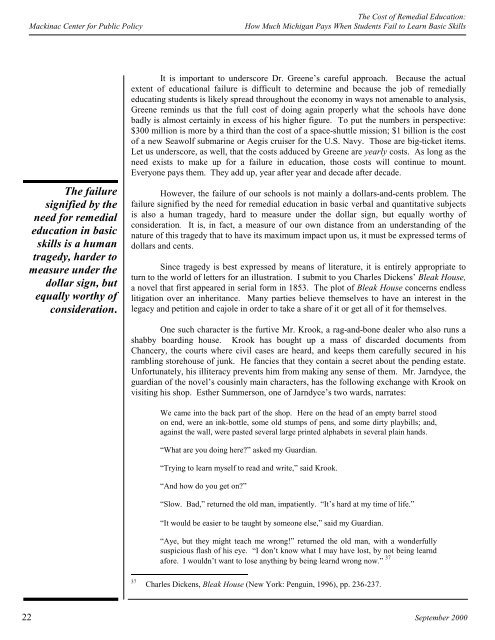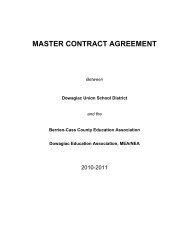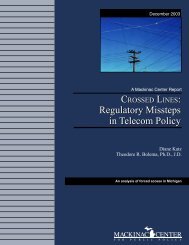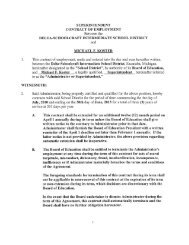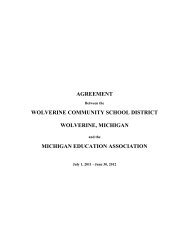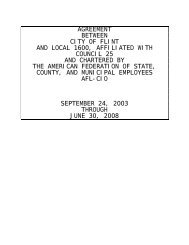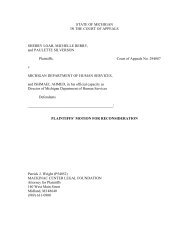The Cost of Remedial Education - Mackinac Center
The Cost of Remedial Education - Mackinac Center
The Cost of Remedial Education - Mackinac Center
You also want an ePaper? Increase the reach of your titles
YUMPU automatically turns print PDFs into web optimized ePapers that Google loves.
<strong>The</strong> <strong>Cost</strong> <strong>of</strong> <strong>Remedial</strong> <strong>Education</strong>:<br />
<strong>Mackinac</strong> <strong>Center</strong> for Public Policy How Much Michigan Pays When Students Fail to Learn Basic Skills<br />
<strong>The</strong> failure<br />
signified by the<br />
need for remedial<br />
education in basic<br />
skills is a human<br />
tragedy, harder to<br />
measure under the<br />
dollar sign, but<br />
equally worthy <strong>of</strong><br />
consideration.<br />
It is important to underscore Dr. Greene’s careful approach. Because the actual<br />
extent <strong>of</strong> educational failure is difficult to determine and because the job <strong>of</strong> remedially<br />
educating students is likely spread throughout the economy in ways not amenable to analysis,<br />
Greene reminds us that the full cost <strong>of</strong> doing again properly what the schools have done<br />
badly is almost certainly in excess <strong>of</strong> his higher figure. To put the numbers in perspective:<br />
$300 million is more by a third than the cost <strong>of</strong> a space-shuttle mission; $1 billion is the cost<br />
<strong>of</strong> a new Seawolf submarine or Aegis cruiser for the U.S. Navy. Those are big-ticket items.<br />
Let us underscore, as well, that the costs adduced by Greene are yearly costs. As long as the<br />
need exists to make up for a failure in education, those costs will continue to mount.<br />
Everyone pays them. <strong>The</strong>y add up, year after year and decade after decade.<br />
However, the failure <strong>of</strong> our schools is not mainly a dollars-and-cents problem. <strong>The</strong><br />
failure signified by the need for remedial education in basic verbal and quantitative subjects<br />
is also a human tragedy, hard to measure under the dollar sign, but equally worthy <strong>of</strong><br />
consideration. It is, in fact, a measure <strong>of</strong> our own distance from an understanding <strong>of</strong> the<br />
nature <strong>of</strong> this tragedy that to have its maximum impact upon us, it must be expressed terms <strong>of</strong><br />
dollars and cents.<br />
Since tragedy is best expressed by means <strong>of</strong> literature, it is entirely appropriate to<br />
turn to the world <strong>of</strong> letters for an illustration. I submit to you Charles Dickens’ Bleak House,<br />
a novel that first appeared in serial form in 1853. <strong>The</strong> plot <strong>of</strong> Bleak House concerns endless<br />
litigation over an inheritance. Many parties believe themselves to have an interest in the<br />
legacy and petition and cajole in order to take a share <strong>of</strong> it or get all <strong>of</strong> it for themselves.<br />
One such character is the furtive Mr. Krook, a rag-and-bone dealer who also runs a<br />
shabby boarding house. Krook has bought up a mass <strong>of</strong> discarded documents from<br />
Chancery, the courts where civil cases are heard, and keeps them carefully secured in his<br />
rambling storehouse <strong>of</strong> junk. He fancies that they contain a secret about the pending estate.<br />
Unfortunately, his illiteracy prevents him from making any sense <strong>of</strong> them. Mr. Jarndyce, the<br />
guardian <strong>of</strong> the novel’s cousinly main characters, has the following exchange with Krook on<br />
visiting his shop. Esther Summerson, one <strong>of</strong> Jarndyce’s two wards, narrates:<br />
We came into the back part <strong>of</strong> the shop. Here on the head <strong>of</strong> an empty barrel stood<br />
on end, were an ink-bottle, some old stumps <strong>of</strong> pens, and some dirty playbills; and,<br />
against the wall, were pasted several large printed alphabets in several plain hands.<br />
“What are you doing here?” asked my Guardian.<br />
“Trying to learn myself to read and write,” said Krook.<br />
“And how do you get on?”<br />
“Slow. Bad,” returned the old man, impatiently. “It’s hard at my time <strong>of</strong> life.”<br />
“It would be easier to be taught by someone else,” said my Guardian.<br />
“Aye, but they might teach me wrong!” returned the old man, with a wonderfully<br />
suspicious flash <strong>of</strong> his eye. “I don’t know what I may have lost, by not being learnd<br />
afore. I wouldn’t want to lose anything by being learnd wrong now.” 37<br />
37<br />
Charles Dickens, Bleak House (New York: Penguin, 1996), pp. 236-237.<br />
22 September 2000


